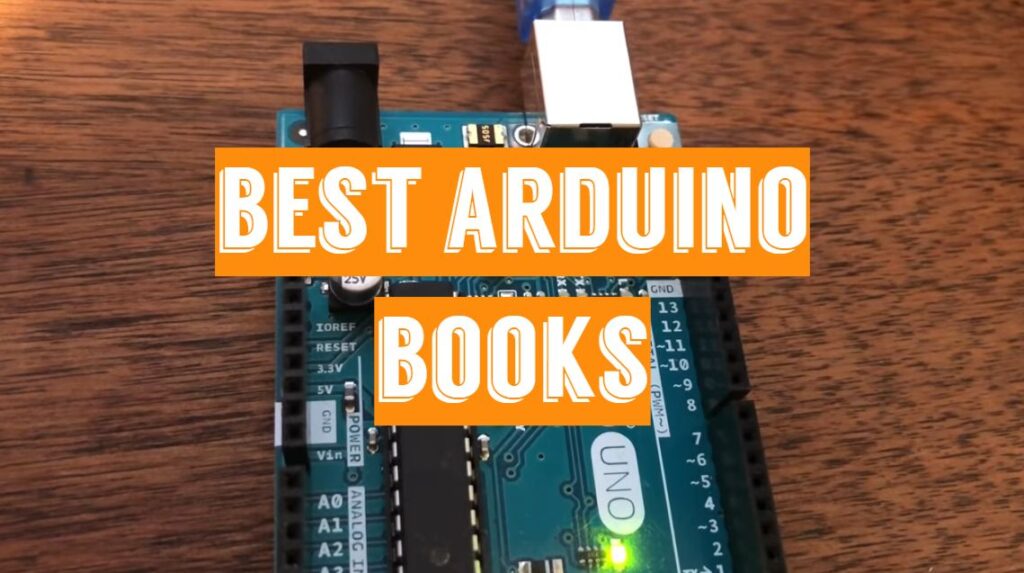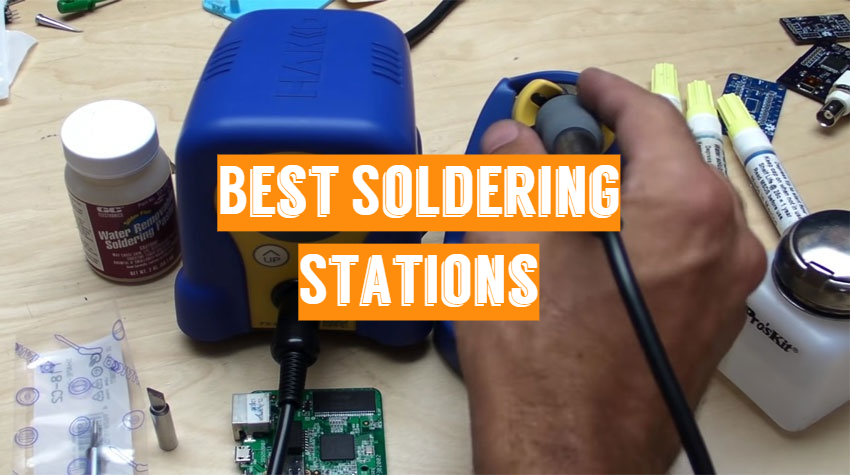
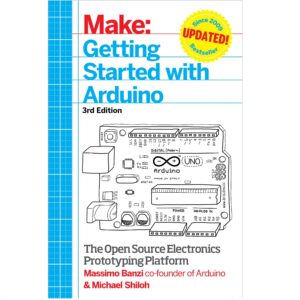
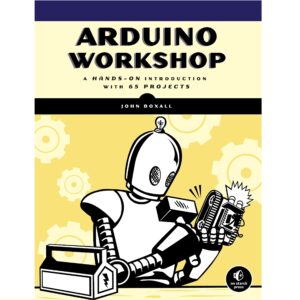
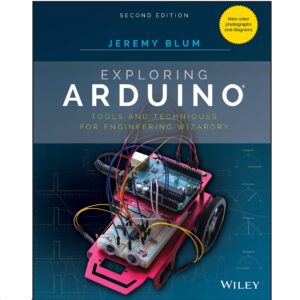
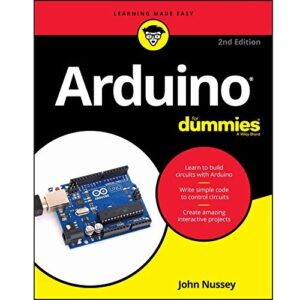
Customer’s Choice: Rated the Best Arduino Books
[survey_answers id=”629597919″ style=”plain” data=”score”] users answered this survey. Please help us improve this review!
[survey_answers id=”629597919″ style=”piechart” legend=”true”]
Arduino is a microcontroller-based open-source electronics tool that is used by millions around the world for electronic ventures. You can compose a few clear pieces of code and integrate Arduino in your works without much awareness of electronics.
The Arduino comprises programmable electronic boards attached to a user interface or software. This user experience is named the Integrated Development Environment (IDE). The Arduino is built to learn to use microcontrollers rapidly and comfortably.
Programming, circuitry, using code and parts to do fun things; that’s essentially what you would anticipate by using an Arduino.
Why should you learn Arduino from a book?
- You can study everywhere;
- It is easy to build the first projects after a few guides without coding skills;
- A great start for beginners;
- The entry level is covered well;
- Affordable and reliable source of information;
A few professionals share the best Arduino books in this guide to get you heading in the right direction. These books explore all ranges of ability and there is sure to be content for everybody on this list.
These simple books will help you learn to compose strong, clean code and proficiently organize your code, as well as help you understand all the core principles of programming. Readers will find precisely tailored Arduino books here to support your career and thrive as a programmer.
To assist you with this choice, the experts prepared the list of some best Arduino books. Check the comparison table and buying guide before the purchase.
Programming Arduino: Getting Started with Sketches 2nd Edition– the best for beginners!
 Simon Monk began this book with Arduino programming basics, before going on to more sophisticated applications. This official guide includes everything from what an Arduino is to its history, multiple models, the IDE implementation, sketches posted, and more.
Simon Monk began this book with Arduino programming basics, before going on to more sophisticated applications. This official guide includes everything from what an Arduino is to its history, multiple models, the IDE implementation, sketches posted, and more.
The book assumes you have no previous programming experience and takes your hand while you discover systematically the fundamentals of programming on Arduino boards. There are several programming samples in the book and you can learn the fundamentals of C as well as compose your libraries.
Not only does the book teach you the fundamentals, it will take you to learn more complex sketches such as writing/retrieving Arduino EEPROM data, playing with LCD monitor screens, etc.
Pros
- Systematic content with handy references;
- Official Arduino book;
- Covers basics of C language;
- The code examples are also available on Github;
- Kindle edition is cheap;
- Neat sketches;
- Includes downloadable programs;
Cons
- Some concepts are not explained;
- No in-depth projects;
- The print is quite small in a paperback version;
For rookies as well as advanced programmers, it could be a perfect book. If you are focusing on an Arduino project, it often serves as a helpful guide. In the sidebars, the author offers a lot of extra material, which you should google and find more information on if you want to.
Make: Getting Started with Arduino: The Open Source Electronics Prototyping Platform 3rd Edition – the best for prototyping from scratch!
 Massimo Banzi (the co-founder of Arduino) released the 3rd edition of his popular Arduino bestseller Make: Getting Started with Arduino guide book for beginners who need detailed tutorials from picking the components to prototyping a new project from scratch!
Massimo Banzi (the co-founder of Arduino) released the 3rd edition of his popular Arduino bestseller Make: Getting Started with Arduino guide book for beginners who need detailed tutorials from picking the components to prototyping a new project from scratch!
This is not the official Arduino guide, however, you might term it the unofficial Arduino Getting Started book, practically. The book is designed for persons having no previous knowledge at all in programming or electronics. It has some interesting projects and begins steadily with a ton of detail, then suddenly begins to presume that you already know about coding and electronics and becomes ambiguous.
This is probably the cheapest Arduino book accessible on the internet. To support you on your journey, the book is strongly recommended as an introductory guide. As a beginner, in a C/C++ programming format, you can quickly get all the assistance you want in simple electronics theory and microcontroller programming.
Pros
- The most affordable Arduino book for beginners;
- Covers software and hardware;
- Starts with simple concepts;
- Hand-drawn diagrams;
Cons
- Not enough projects;
- No technical references;
In brief, this is the perfect book for you to understand Arduino whether you are a novice with some programming experience or an advanced user.
Arduino Workshop: A Hands-On Introduction– the best for the number of projects!
 John Boxall’s Arduino Workshop includes 65 projects for intermediate and advanced hobbyists who use electronics at home or the workplace. This book explains how add-ons work and how they can be implemented into your Arduino projects.
John Boxall’s Arduino Workshop includes 65 projects for intermediate and advanced hobbyists who use electronics at home or the workplace. This book explains how add-ons work and how they can be implemented into your Arduino projects.
You will start with a description of the Arduino framework, but pass on to the coverage of different electronic components and principles quickly.
The book addresses topics ranging from the very basics (such as setting up Arduino and downloading the IDE) to the further application of this information in projects by demonstrating how to build a sketch; how current, voltage, or power functions inside these devices; and how to integrate all this knowledge into your projects.
Pros
- 65 projects that cover devices, toys and games;
- Easy to read and follow;
- Covers the integration with different Arduino shields;
Cons
- No detailed recipes or kits included;
If you’re very interested in researching Arduino, this version is perfect. It will take you all the way from flipping on LED lights to making a tester for battery cells. Each project is distinct, and the author clarifies the project’s whole process and purpose. Each line of code is clarified well, but you will be able to compose the code on your own while you move on doing further ventures.
Exploring Arduino: Tools and Techniques for Engineering Wizardry 2nd Edition – the best for advanced users!
 Jeremy Blum, Arduino guru, guides you through each build, including samples of code and schematics that will stay helpful for potential ventures. To represent the quickly growing Arduino ecosystem, this latest 2nd version has been revised and provides new full-color graphics for better reference.
Jeremy Blum, Arduino guru, guides you through each build, including samples of code and schematics that will stay helpful for potential ventures. To represent the quickly growing Arduino ecosystem, this latest 2nd version has been revised and provides new full-color graphics for better reference.
This book provides a detailed tour of the hardware itself, including an in-depth guide to the different peripherals, instruments and methods used to create something functional, decorative, and instructional with your little Arduino computer. Exploring Arduino is your adventure roadmap and launch your journey today.
Pros
- The basics are covered in-depth;
- Versatile projects and components are covered;
- Full-color graphics;
- Good for intermediate and advanced users;
- Many downloadable materials;
Cons
- Expensive;
- No step-by-step guides;
This guide gives a good compromise between the software/hardware sides of Arduino projects. The author is also very competent and, irrespective of your technical experience, his style of writing should be easy to consume.
Arduino For Dummies 2nd Edition – the best for the easy read!
 Arduino is a hobbyist’s fantasy. This is a reference for John Nussey. Arduino for Dummies is cheap, available, and extremely customizable. Arduino helps you to think about and play with technology, whether you’re an artist, a builder, a programmer, or just an interested person.
Arduino is a hobbyist’s fantasy. This is a reference for John Nussey. Arduino for Dummies is cheap, available, and extremely customizable. Arduino helps you to think about and play with technology, whether you’re an artist, a builder, a programmer, or just an interested person.
Educators use it in real-life experiments to teach programming and circuitry. You can get started with this novel, or it can expand the skills you already have. You can discover the materials you need and where to find them, read more about energy, and draw drawings to check out. You will soon be manipulating lighting and generators, and maybe even creating your robot!
Pros
- Covers the latest Arduino software and hardware;
- Simple examples to learn fundamentals;
- Affordable;
- Easy to consume;
Cons
- Useful only for beginners;
- Not enough projects;
Although the projects are very simple in this book (scrollable sigh, Arduino clock), it gets a little more complex. It also offers you all the resources you can need on your own to further simplify it.
The Buyer’s Guide
Arduino is a prototyping device for open-source tech, focused on modular hardware/software that is simple to use. It is meant for creators, programmers, enthusiasts and anybody who is involved in designing items or worlds that are immersive. To learn the details about Arduino boards and shields, you need to choose the special books according to these criteria:
The education level:
- For beginners. Most of the books in this list belong to this category. If you’d like to start experimenting with Arduino and you’re low on time take a fast glance at the books of other beginners and see if it’s anything that would attract you, look for such titles. Consider purchasing the Getting Started with Arduino parts kit that already includes all the parts required to complete the workouts of any beginner’s book;
- For intermediate users. Typically, such books include a series of practical Arduino “recipes”. They cover the basics but focus on more practical tips and detailed descriptions of intermediate projects. Recommended for the users who’ve already read a few beginner’s books;
- For professionals. There are advanced Arduino books that cover radio, WiFi and Bluetooth connectivity. Such books are far more reliable than fast tutorials and guides and can become a really valuable source of knowledge;
The key reason for this is that books typically go through different levels of double-checking of the details such that you are less likely to be mistaken during the learning phase.
The book’s design
Despite the content, pay attention to the style and design of an Arduino book. It needs to be published well, with plenty of diagrams. In other terms, when developing and creating your functional application with Arduino, it must include a very practical guide to how to link every form of hardware and resolve issues you are likely to find. Preferably, invest in the book that is available in paper and digital editions.
Table of contents
The table of contents (TOC) is the perfect place to begin your evaluation of a programming book. If the particular topics you are seeking to understand do not exist in the TOC somewhere, so you should conclude that any coverage found in the book would prove too cursory to be really useful to you.
To see how they’re structured, users can browse through a few chapters. Some writers settle for only one or two methods, which are not often helpful, to clarify a topic. Three or four methods of studying a topic, including hands-on experiments, source code, comprehensive examples, and procedures, are provided in the best books.
Find out the explanatory pages. Long and boring introductions could mean a book that includes a ton of fluff you do not need. On the other side, you might notice that the definitions lack the requisite specifics because the presentations are too brief to completely introduce the content which will leave you more frustrated than when you began reading.
Also a good index is important. Look at a couple keywords you’re interested in. You certainly won’t be able to identify them in the book either if they don’t feature in the index.
Not only does a great index include the keywords you need but also it organizes them in such a way that you see more areas with similar knowledge to search for. There should also be more advanced programming examples in the book for you to progress toward.
The author’s reputation
In order to compose well-researched, structured, and interesting books, professional writers are compensated. While not often the case, partnerships published by three or more writers can often neglect emphasis, divert you from different types of writing, or even include contradictory details.
What topics should be covered in a useful Arduino book:
- How to use basic boards and shields;
- Description of a starter kit if it comes with one of such kits;
- “Getting started” lessons;
- Description of different open-source projects with step-by-step guides;
Is it worth buying Arduino books in bundles?
The last primary group of Arduino starter packs is kits that include books. They generally, though, contain a paperback book that describes in more depth the tests and electronic basics. The approved Arduino starter kit is one case.
There are various Arduino starter kits online. To guarantee a minimum of consistency, you should not settle for the cheapest one, but you should also not spend too much on these kits. It’s crucial that you look at the contents closely. As several of these kits arrive without the board to decrease the cost, ensure that an Arduino programming board is provided.
Video Tutorial: Arduino Programming
Final thoughts
Probably Arduino is the most common robotics and IoT framework, and there are loads of books on the market to read, not to overlook the free online tutorials and other tools. Hopefully, you may want to use one of these popular Arduino books when learning one of these kits. There’s a lot of fantastic books out there and you can find them in no time with a little studying.

